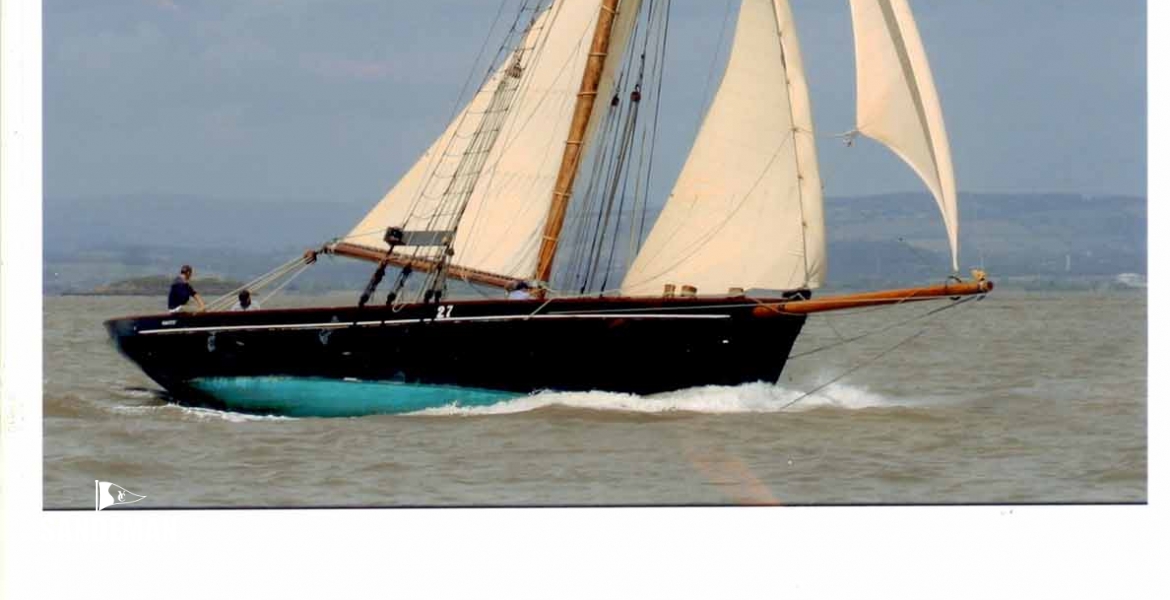
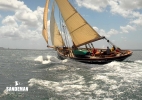
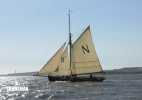
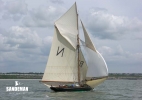
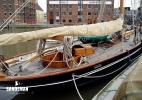
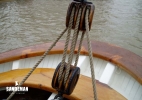
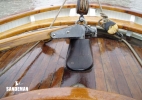
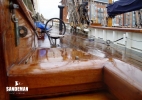
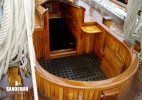
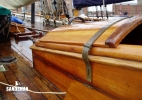

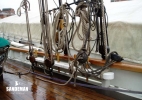

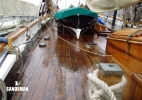
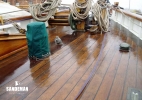
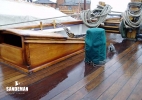

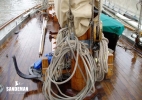
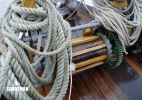
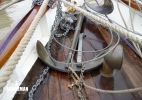
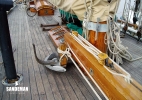
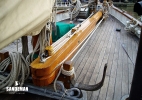
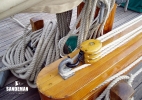


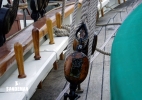
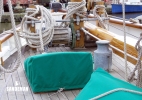
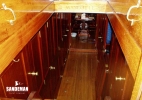

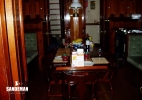
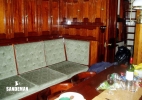

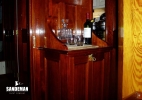
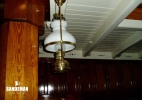
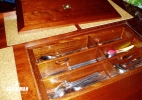
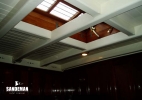
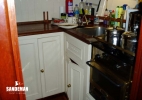
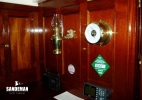

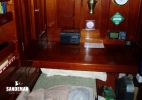
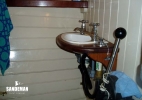

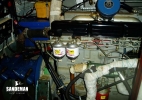
| Designer | Thomas Cox |
|---|---|
| Builder | Thomas Cox |
| Date | 1904 |
| Length overall | 60 ft 0 in / 18.28 m |
| Length deck | 0 ft 0 in / 0 m |
| Length waterline | 0 ft 0 in / 0 m |
|---|---|
| Beam | 15 ft 0 in / 4.57 m |
| Draft | 9 ft 10 in / 3 m |
| Displacement | 55 Tonnes |
| Construction | Larch hull and Douglas fir deck |
| Engine | 6-cylinder Ford 140 HP |
|---|---|
| Location | Swansea, UK |
| Price | Sold |
These details are provisional and may be amended
MASCOTTE is no pretender – she is the largest of the surviving pilot-cutters and her story is remarkable. The sailing cutters of the Bristol Channel were ruggedly designed and built to withstand some of the wildest seas around our coasts and there is no doubt they were amongst the strongest and most efficient sailing craft ever produced.
Now totally restored by T Nielsen & Company of Gloucester for her current owner for film and charterwork (fully MCA Coded), she is authentic in every way with every item both above and below deck having been carefully replaced or restored – an exquisite Edwardian-style interior with mahogany panelling offering guest berths for up to 9 people – hydraulic drive to twin max props make MASCOTTE nimble under engine.
MASCOTTE has proven herself as a spectacular racing cutter as well as a charter business. It is difficult not to fall under her spell before even leaving the dock.
Interested in MASCOTTE in more detail.
MASCOTTE was built in 1904 by pilot Thomas Cox of Newport and boat builder William Stacey. Cox, with a Barry & Newport Licence had a Newport Pilot son and a nephew who was a Barry Pilot – MASCOTTE accommodated all three of them and was therefore built 60 ft overall (10 ft longer than most pilot cutters!) She was twice as heavy. The service and flexibility that MASCOTTE could offer made her owners wealthy men.
An example of the distances sailed to find a ‘profitable ship’ – MASCOTTE once sailed around Land’s End and on to Dover to meet a ship from London bound for Newport.
For 11 years she gave yeoman service until 1915 when the advent of the steam cutters put her and many others out of business and she was sold out of the pilotage service.
Several different owners sailed the boat in the following 3 decades -
variously within fashionable yachting circles and cruising to Scotland and
the Orkney Islands. Modifications to her spec included removing ballast to
reduce her draft, raising bulwarks and installing wheel steering - allowing more cockpit room for entertaining.
During World War II, MASCOTTE was laid up at Hamble.
In 1957, she narrowly escaped the breaker’s yard, and was turned into a
houseboat. But in 1980 she was discovered languishing in the River Medina by Paul Kennard who, recognising the quality of design, bought her and towed her to his home port of Rye. He undertook her restoration, replacing much of
her planking, although keeping the higher bulwarks. He sailed her to
Portugal, but on her return put her up for sale.
She was then bought by a Cardiff brewery and suffered a short period of
neglect. In 1994, her new and current owner Tony Winter commissioned Tommi Nielsen to bring MASCOTTE back to her former glory as a working Bristol Channel Pilot Cutter. Her final restoration, completed in April 1995, won her work in film and television.
MASCOTTE was built to traditional lines. A fast but seakindly hull form. Larch planking on oak frames and Douglas fir deck.
MASCOTTE is tiller-steered from her original cockpit. The cockpit is deep and well protected; the engine and throttle controls are neatly concealed in their own boxes. The vessel has her original wide flush decks, Iroko king plank and oak covering boards with the only alteration being a butterfly hatch sympathetically added aft of the mast. An 11 ft 6 in punt sits at a mid-deck position. The forward section of the vessel can be entered by a sliding hatch forward of the mast. The foredeck reflects the attention for detail in MASCOTTE’s restoration as she boasts an anchor windlass and a replica period anchor windlass.
MASCOTTE has 9 berths in 5 cabins. Passing through the companion way and down the steps the accommodation aft is entered off a passageway made up of beautiful varnished mahogany panelling – the Edwardian style is continued throughout the accommodation.
Moving forward in the boat there are two identical double guest cabins port and starboard. Moving forward and to port is the aft wc/heads with wash basin; to starboard is a ‘captain’s cabin’ with chart table, plenty of hanging lockers and single berth – a hatch folds down in the passageway so the GPS and instruments can be used without entering the cabin and communication can be kept easily between the cockpit and the navigator. There are electric and paraffin lamps in each cabin and the upholstery throughout is period and immaculate. Finally to port, before entering the main saloon, is the engine room – elegantly disguised; it would be easy to mistake the space from outside for more accommodation.
The main saloon is at the end of the passageway and it does not disappoint. Seven people can sit for a meal around the saloon table, and a Stovax coal stove is situated to starboard (certainly making out-of-season sailing less severe). Either side of the saloon are beautifully upholstered built-in seating that can be used for 2 more berths if the ship is well crewed. The mahogany joinery is faultless with much storage space beautifully disguised by the detail. The deck head is painted white – the large butterfly hatches aft of the mast add to the ambience and add light to the saloon.
The gallery is forward of the saloon and to starboard, well equipped with stove and oven, fridge and work spaces. MASCOTTE is equipped with fire-fighting equipment and medical stores, as required by the Coding authority.
The forward accommodation is made up of 2 further cabins accessed either by the saloon and galley or from the deck by the forward hatch. The first cabin has two bunks to port and the forward cabin has a typical V-berth – both have use of a forward wc/shower compartment (manual shower pump).
6-cylinder Ford diesel 140 hp – hydraulic drive, twin screw (feathering propellers)
Two water tanks – 70 gallons each
Diesel tank 167 gallons / 750 litres
Main mast and bowsprit (pitch pine) – 1995 T Nielsen & Co
Gaff (Sitka spruce) – 1994 T Nielsen & Co
Boom (Douglas fir) - 1994 T Nielsen & Co
Main Sail – Terry Ratsey 1994
Foresails
- No. 1 Jib – Terry Ratsey 1994
- No. 2 Jib – Terry Ratsey 1994
- No. 3 Jib – Terry Ratsey 1994
Reaching Genoa – Terry Ratsey 1995
Balloon jib – Terry Ratsey 1995
Top Sail – Terry Ratsey 1995
Yard Top Sail – Terry Ratsey 1995
Jib Top Sail - Lawrence
Foresail - Lawrence 2007
Storm Jib - Terry Ratsey 1995
Spare Foresail - Terry Ratsey 1994
6 Domestic batteries
Dedicated engine start battery
Generator
3kw Fisher Panda generator
Hot water calorifier off engine with 240v immersion alternative
Jabsco engine mounted bilge pump
Whale Gusher Titan pump
3 Fishermans anchors (2 bow anchors 36 kg / 36 kg / 1 kedge anchor 29 kg)
12-man life raft
13 life jackets
rope ladder
All medical stores and firefighting equipment as required by the Coding authority
11ft 6 in punt stored mid-deck. This custom-made tender is a copy of a period punt from cutter HILDA and is equipped with a Mariner Outboard
Two oars and lug-sail
GPS
VHF DSC
Echosounder
MASCOTTE has proved an exceptional boat very suitable for filming and TV work and is regularly invited to festivals of sail.
Sailing in these cutters in the waters for which they were built has an atmosphere and excitement that is impossible for me to put into words – something of those legendary days a century ago is recaptured when several cutters race each other in fresh conditions in their home waters. Long may it continue.
Contact us to discuss MASCOTTE in more detail.
These particulars have been prepared from information provided by the vendors and are intended as a general guide. The purchaser should confirm details of concern to them by survey or engineers inspection. The purchaser should also ensure that the purchase contract properly reflects their concerns and specifies details on which they wish to rely.